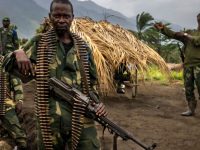600 Killed, 1,000 Kidnapped, Churches empty, Villages Burn as ISIS Affiliate Ravages Congo

By Nasir Dambatta, with additional reports from ADF Magazine
A fresh wave of terror is sweeping across eastern Democratic Republic of Congo (DRC), where an ISIS-linked insurgent group, the Allied Democratic Forces (ADF), has unleashed an orgy of violence that has left more than 600 people dead, 1,000 kidnapped, and entire villages torched in recent months. The group’s resurgence underscores how fragile peace remains in one of Africa’s most conflict-scarred regions.
The ADF, originally a Ugandan rebel faction, has transformed into one of the deadliest branches of ISIS in sub-Saharan Africa. Now operating deep inside DRC’s North Kivu and Ituri provinces, the group’s attacks have become more coordinated, more brutal, and more symbolic. Churches, schools, and marketplaces have turned into slaughter zones, as civilians bear the brunt of its latest campaign of terror.
In July, the group stormed a night Mass in Komanda, killing 43 worshippers, including 19 women and nine children. Barely two months later, on September 9, it struck again in Lubero — massacring over 70 people, abducting about 100 mourners, and burning 16 homes to the ground. Survivors told local monitors that the assailants “moved like ghosts in the dark,” shooting and hacking indiscriminately before setting the church ablaze.
Days later, ADF gunmen descended on the Catholic mission in Ntoyo, North Kivu, killing “dozens” more. According to The Lion, a digital monitoring service, these atrocities brought the year’s death toll to at least 600, placing 2025 among the deadliest periods in the DRC’s recent history.
Local authorities and human rights groups now warn that the ADF’s latest wave of attacks is not random. Intelligence briefings shared with Ugandan and Congolese forces suggest that the ADF has forged new alliances — particularly with the Lendu militant coalition, known as the Cooperative for Development of the Congo (CODECO). This tactical alignment has emboldened insurgents and widened their area of control.
“The [Allied Democratic Forces] are no longer alone,” said a traditional chief in Kasenye, Lubero. “Other armed groups with similar methods are operating in the shadows.”
Security analysts interpret this as an effort by the ADF to consolidate influence under the banner of religious extremism, while tapping into Congo’s long-running ethnic and land conflicts to recruit fighters and intimidate rival groups.
Yet beyond the geopolitical calculations lies a devastating human story. In the aftermath of each attack, villages are left ghostly and silent. Thousands have fled to displacement camps in Beni and Ituri, where food, shelter, and medical care remain desperately scarce. Aid workers report that entire communities have been uprooted — families torn apart by abductions, and children forced to witness scenes of horror no human should ever see.
“We’re truly in shock,” one woman told Agence France-Presse after the Komanda massacre. “Children and women have been killed. What are the security services doing here? They’re not doing anything at all.”
Her lament reflects a growing frustration with Congolese security forces and UN peacekeepers, whose presence — though large — has done little to deter the rebels. The Ugandan army’s cross-border operations, too, have failed to contain the insurgency. In fact, the ADF appears to be adapting — dispersing into smaller cells and using the vast, forested terrain of eastern DRC as a shield against air and ground offensives.
For regional security observers, the crisis carries a chilling warning. The DRC’s ungoverned spaces, already teeming with dozens of militias, risk becoming an even larger sanctuary for ISIS affiliates if global and regional responses remain fragmented. The United Nations estimates that more than 7 million people are now displaced within the Congo — the highest in Africa — and escalating jihadist violence threatens to worsen that humanitarian catastrophe.
What makes the ADF particularly dangerous is its hybrid nature — a blend of local rebellion and global jihad. While it professes allegiance to the Islamic State, some of its actions contradict IS policy, hinting at a rogue franchise exploiting religion to mask political and criminal motives.
As the world’s attention drifts elsewhere — from the Middle East to Ukraine — eastern Congo’s agony deepens in silence. The victims of Komanda, Lubero, and Ntoyo remain nameless beyond their burned-out churches and empty villages. Yet their suffering paints a grim portrait of a nation where the rule of law is fading, and where terror — not governance — dictates who lives and who dies.
Until the DRC and its neighbors develop a coherent counter-insurgency strategy, the ADF’s campaign of blood will continue unchecked — and the phrase “600 killed, 1,000 kidnapped” may soon sound like a conservative estimate.










